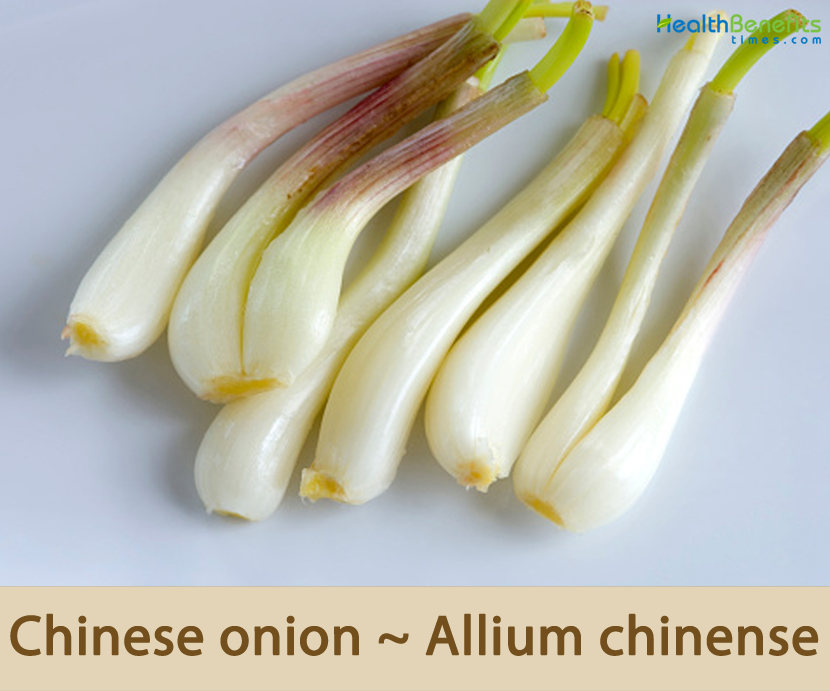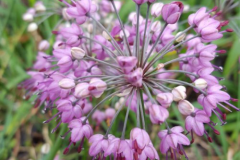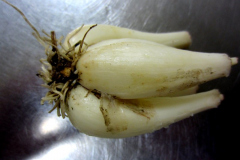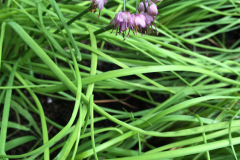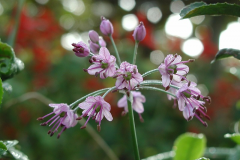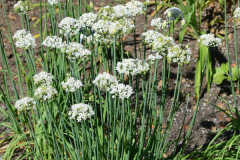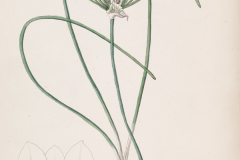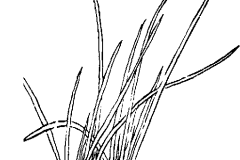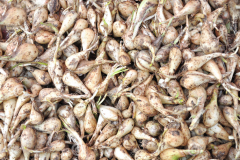| Chinese onion Quick Facts | |
|---|---|
| Name: | Chinese onion |
| Scientific Name: | Allium chinense |
| Origin | Occurs spontaneously in Central and Eastern China (in Anhui, Fujian, Guangdong, Guangxi, Guizhou, Hainan, Henan, Hubei, Hunan, Jiangxi and Zhejiang provinces) and in Japan, Korea, Russia and Mongolia |
| Taste | Acrid, sweet |
| Health benefits | Support stuffiness sensation and pain in the chest, angina pectoris, pleurisy, bronchitis, diarrhea, dysentery, mental stress, heart problems, and tumors, headaches. |
| Name | Chinese onion |
|---|---|
| Scientific Name | Allium chinense |
| Native | Occurs spontaneously in Central and Eastern China (in Anhui, Fujian, Guangdong, Guangxi, Guizhou, Hainan, Henan, Hubei, Hunan, Jiangxi and Zhejiang provinces) and in Japan, Korea, Russia and Mongolia. It is widely cultivated in China and Japan. It is also cultivated in Southeast Asia (Cambodia, Laos, Vietnam, Thailand, Myanmar, Malaysia, Singapore and Indonesia) and introduced with oriental emigrants from this region into further areas, e.g. the United States (Hawaii, California) and Cuba |
| Common Names | Baker’s Garlic, Chinese Onion, Chinese Scallion, Chinese Shallots, Japanese Scallion, Kiangsi Scallion, Kiangsi Shallot, Oriental Onion, Rakkyo, Small Angled Chives, Small angled chives, Chinese chives, glittering chive, Naga garlic, Glittering chive |
| Name in Other Languages | Afrikaans: Chinese ui Angami: Khova Arabic : Tum El-Khabazeen, thum siniun (ثوم صيني) Bulgarian: Kitaĭski luk (китайски лук) Chinese : Cong He Xie (葱和薤), Hsieh, Xie-Tou, Hsieh- Tou, Jiao Tou (茭头), Ku Jiao, Qiao Tou Tsung Tao, Xie, Ying Xie, Lěi tóu (蕌头 ), Lěi tóu xiè (蕌头薤) , Hé xiè (和薤) , Tou (头) Czech : Česnek Rakijo Danish : Rakkyo, Rakkyoløg English: Chinese onion, Chinese scallion, Japanese scallion, Oriental onion, rakkyo, Kiangsi scallion Estonian : Rakkiolauk Finnish : Valkoruohosipuli French : Échalote Chinoise, Rakkyo, oignon de Chine German: Rakkyo Greek: Állio to kinezikó (Άλλιο το κινεζικό) Hebrew : Shum sini Hungarian: Iyabasi Indonesia: Longkio, Bawang Kucai ( Java ) Bawang Ganda ( Malay ) Japanese: Rakkyō, Rakkyou, Esharetto (エ シャレット ), Hana Rakkyou, Shima Rakkyou, Tama Rakkyou, Rakky, Hana rakkyō (花ラッキョウ ), Shima rakkyou (島らっきょう), Tama rakkyou (タ マラッキョウ) Korean : Yeom Kyo (염 교), yeom bu chu (염부추), yeomgyo Malaysia : Lokyo Mizo: Thip-pu-run Polish : Szczypiorek chiński Portuguese : Chalota Chinesa, cebola-da-china Russian: Luk kitayskiy (лук китайский) Spanish : Chalote Chinesa, Cebollino De La China, Cebolinha para picles, rakkyo Swedish : Rakkyolök Tangkhul: Somri Thailand : Mee Yoi, Krathiam-Chin, Hom-Prang, Hom-Paenyuak, Hom prang, Krathiam chin (กระเทียมจีน) Vietnamese : Kieu, Củ Kiệu |
| Plant Growth Habit | Evergreen, clustered, caespitose perennial, bulb-producing plant |
| Soil | Prefers well-drained, friable and moderately fertile soils such as sandy loams and thrives in full sun. Too fertile soil such as the volcanic ash results in large and soft bulbs and a decrease in market value |
| Plant Size | About 0.5 m tall |
| Root | Adventitious roots |
| Bulb | Narrowly ovoid to ellipsoid, 1–4 cm in diameter with a white, membranous coat which is often tinged with reddish purple and gradually merging into the leaf blades at the top |
| Leaf | Hollow but the scape is solid. Leaves are distichous, cylindrical, hollow, 20–50 cm by 1–5 mm and 3–5 angled. Scape is lateral, 20–40 cm, terete and solid covered with leaf sheaths only at the base. |
| Flowering season | August to September |
| Flower | Flowers are campanulate, purplish with six tepals arranged in two whorls, six stamens and a pistil longer than the tepals. Filaments equal, 1.5 × as long as tepals, connate at base and adnate to tepals |
| Propagation | By division |
| Taste | Acrid, sweet |
| Plant Parts Used | Flowers, oil, leaves, root |
Plant Description
Chinese onion is an evergreen, clustered, caespitose perennial, bulb-producing plant that normally grows about 0.5 m tall from an underground bulb. The plant divides, forming in time a clump of growth. The plant prefers well-drained, friable and moderately fertile soils such as sandy loams and thrives in full sun. Too fertile soil such as the volcanic ash results in large and soft bulbs and a decrease in market value. It is tolerant of a range of growing conditions. These plants may go dormant in early summer, and return to growing during monsoon or at the latest, fall. They multiply almost as much as multiplier onions.
Bulb
Bulbs are narrowly ovoid to ellipsoid, 1–4 cm in diameter with a white, membranous coat which is often tinged with reddish purple and gradually merging into the leaf blades at the top.
Leaves
Leaves are bright green, hollow but the scape is solid. Leaves are slender and thin-walled, distichous, cylindrical, hollow, 20–50 cm long and 1–5 mm wide and 3–5 angled. Scape is lateral, 20–40 cm, terete and solid covered with leaf sheaths only at the base.
Flowers
Inflorescence consists of a hemispheric umbel with 6–30 lax flowers with two-lobed persistent spathe on a stalk 40-60 cm long. Flowers are campanulate, purplish with six tepals arranged in two whorls, six stamens and a pistil longer than the tepals. Filaments are equal, 1.5 × as long as tepals, connate at base and adnate to tepals; outer ones subulate; inner ones broadened at base, one toothed on each side. The ovary is obovoid–globose, with concave nectaries covered by hood like projections at the base. Style exserted. Flowering normally takes place in between August to September.
Chinese onions are a rich source of calcium, magnesium and phosphorus. They also contain fructan, which helps to reduce the risk of cancer and heart disease; selenium, which has anti-cancer effects; and saponin.
Traditional uses and health benefits of Chinese onion
- Chinese onion is astringent, carminative and expectorant and is used in the treatment of stuffiness sensation and pain in the chest, angina pectoris, pleurisy, bronchitis, diarrhea and tenesmus in cases of dysentery.
- Chinese onion is used as a folk medicine in tonics to help the intestines and as a stomachic.
- They contain sulphur compounds and when added to the diet on a regular basis they help reduce blood cholesterol levels, act as a tonic to the digestive system and also tonify the circulatory system.
- In traditional Chinese medicine, plant bulbs are reputed to cure mental stress, heart problems, and tumors etc., and are also incorporated in several medicinal preparations.
- The bulbs of Chinese onions are said to be good for heart problems, headaches and tumors.
Culinary Uses
- The bulbs and leaves are edible raw or cooked.
- Bulbs are used raw or fried mixed with other vegetables in Indonesia.
- Bulbs are widely used as sweet or sour pickles after steeping in salt for several days.
- In Japan, they are used mainly in pickles as side dishes, often eaten with Japanese curry.
- It is used as a pickled meal during Vietnamese New Year – Tet celebrations.
- Leaves can be consumed raw or cooked.
- Flowers and young seedpods can be consumed raw.
- It is used as a garnish on salads.
- Chinese onion is often pickled and served as a side dish in Japan and Vietnam to balance the stronger flavor of some other component in a meal.
- It is eaten as a garnish on Japanese curry.
- Bulbs are consumed raw or cooked.
- It has an excellent crisp texture with a strong onion flavor.
- Bulbs are often steeped in brine and subsequently processed into sweet or sour pickles and served as a side dish in Japan and Vietnam.
- In North-East regions of India the bulbs crushed or mixed with chili and some dried meats served as favorite part of a meal.
- The Leaves, flowers and young seed pods are consumed raw or cooked.
- They are used raw as a garnish on salads
- It may be used as a topping for dishes like miso soup.
- They may also be served with sushi, which helps to balance any saltiness.
- Chinese onions are most often steeped in brine before being marinated in vinegar, sake and sugar.
Other Facts
- The juice of the plant is used as a moth repellent.
- The whole plant is said to repel insects and moles.
- In Vietnam, pickled Chinese onion is traditionally served for New Year.
Precautions
- There have been cases of poisoning caused by the consumption, in large quantities and by some mammals, of certain members of this genus.
- Do not apply on sores.
- Dogs seem to be particularly susceptible.
References:
https://www.itis.gov/servlet/SingleRpt/SingleRpt?search_topic=TSN&search_value=506482#null
https://pfaf.org/user/Plant.aspx?LatinName=Allium+chinense
https://en.wikipedia.org/wiki/Allium_chinense
https://www.flowersofindia.net/catalog/slides/Chinese%20Onion.html
https://gd.eppo.int/taxon/ALLCH
http://tropical.theferns.info/viewtropical.php?id=Allium+chinense
http://www.narc.gov.jo/gringlobal/taxonomydetail.aspx?id=101417
https://inaturalist.nz/taxa/122344-Allium-chinense
http://www.theplantlist.org/tpl1.1/record/kew-295288
https://www.cabi.org/isc/datasheet/4240
https://davesgarden.com/guides/pf/go/202608/#b
https://plants.usda.gov/home/plantProfile?symbol=ALCH5


